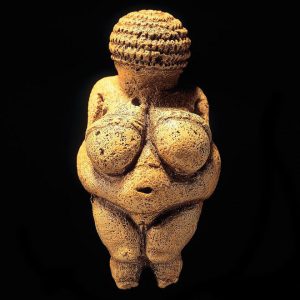Symbol of fertility, good luck
The Willendorf is a statue discovered by Joseph Szombathy that dates back to 30,000 and 25,000 BC. It is a statue of a woman figure measuring about four inches high. It was colored by red Orche and carved from limestone which was not local to the area this figurine was found. It is believed to be a Venus figure and a symbol of fertility. It is also believed to be a symbol of nature and goddess.
The Willendorf has a womanly shape with enlarged breasts and stomach with an enhanced pubic area symbolizing procreativity. The red Orche paint symbolizes the menstrual flow, which represents life. It is also thought to be a good luck charm carried by hunters.
The Willendorf figure is faceless and has seven concentric braids. Seven is considered a lucky number. The figure represents the great mother that birthed the world and all humankind and provided for our existence.
The tribe that carved this figure was located in Europe. They were probably a nomadic matriarchal tribe that worshiped a female deity.

» Amulet
» Ajna
» Arsenic
» Merkaba
» Hung
» Yin Yang
» bindi
» IK Onkar
» Khanda
» Halo
» jiahu
» Tau
» Uraeus
» Menorah
» Quincunx
» Tilaka
» Taijitu
» Vajra
» Chai
» Chi Rho
» Bagua
» Dragon
» Hunab Ku
» Caduceus
» Infinity
» Ichthus
» Hedjet
» Lauburu
» Om
» Ankh
» Chalice
» Pentacle
» Maat
» Ogham
» Mandala
» Kartika
» Khamsa
» Heart
» Labrys
» Sun Face
» Raven
» Triskele
» Scarab
» Dove
» Hanukia
» Anubis
» Trishula
» Durga
» Mezuzah
» Bay Tree
» Geruda
» Kinnara
» Quito
» Condor
» Blue Jay
» Falcon
» Makara
» Rosary
» Uluru
» Apsaras
» Hanuman
» Serpent
» Minotaur
» Mercury
» Apex
» Vestra
» Yoni
» Astarte
» dakini
» Calabash
» Mandrake
» Rebis
» Typhon
» Vegvísir
